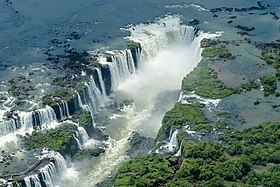| Iguazú Falls | |
|---|---|
 | |
 | |
| Location | Argentina: Misiones province Brazil: Paraná state |
| Coordinates | 25°41′12″S 54°26′41″W / 25.68667°S 54.44472°W |
| Number of drops | 275[1] |
| Longest drop | 82 metres (269 ft)[1] |
| Watercourse | Iguazu River |
| Average flow rate | 1,756 m3/s (62,010 cu ft/s)[1] |
Iguazú Falls or Iguaçu Falls (Guarani: Chororõ Yguasu [ɕoɾo'ɾõ ɨɣʷa'su], Spanish: Cataratas del Iguazú [kataˈɾatas ðel iɣwaˈsu]; Portuguese: Cataratas do Iguaçu [kɐtɐˈɾatɐz du iɡwɐˈsu]) are waterfalls of the Iguazu River on the border of the Argentine province of Misiones and the Brazilian state of Paraná. Together, they make up the largest waterfall system in the world.[2] The falls divide the river into the upper and lower Iguazu. The Iguazu River rises near the heart of the city of Curitiba. For most of its course, the river flows through Brazil; however, most of the falls are on the Argentine side. Below its confluence with the San Antonio River, the Iguazu River forms the border between Argentina and Brazil.
The name Iguazú comes from the Guarani or Tupi words "y" [ɨ], meaning "water", and "ûasú" [waˈsu], meaning "big".[3] Legend has it that a deity planned to marry a beautiful woman named Naipí, who fled with her mortal lover Tarobá in a canoe. In a rage, the deity sliced the river, creating the waterfalls and condemning the lovers to an eternal fall.[3] The first European to record the existence of the falls was the Spanish Conquistador Álvar Núñez Cabeza de Vaca in 1541. It was inscribed into the UNESCO World Heritage List in 2013.
- ^ a b c Cite error: The named reference
Britannicawas invoked but never defined (see the help page). - ^ Couzens, Dominic (2008), Top 100 Birding Sites of the World, University of California Press, p. 228, ISBN 978-0-52-025932-4
- ^ a b Hamre, Bonnie. "Iguazu Falls". About.com Travel. Archived from the original on 3 January 2016. Retrieved 11 January 2008.

